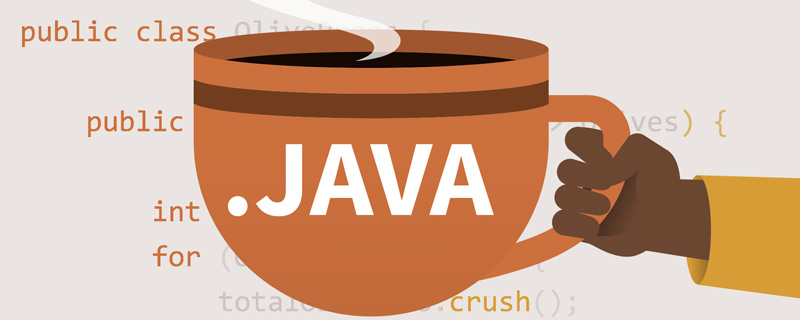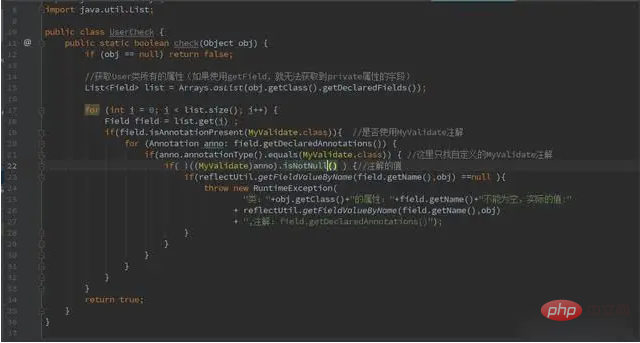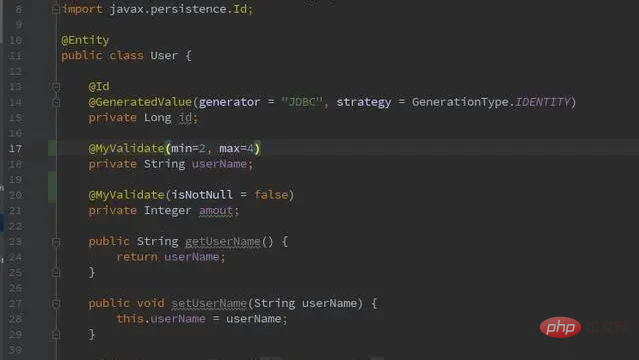How to implement custom annotations in java
How to implement custom annotations in java: first create a new java file and customize an annotation; then use meta-annotations to define various items; and finally define the business logic of the annotation.

How to implement custom annotations in java:
1. Customize an annotation (MyValidate) and use the element The annotation defines various uses

2. Define the business logic of the annotation. Only one attribute of the annotation is implemented here: isNotNull()

Then you can use it happily

In actual projects, it is implemented through interceptors or aspects:
1. Define a interface, named BaseCheck. There is an abstract check method in BaseCheck, and the return value of the check method is boolean.
2. Define verification annotations, such as: @NotNull, @Length.
3. According to the above annotations, define corresponding verification classes, such as: NotNullCheck, LengthCheck.
4. NotNullCheck and LengthCheck both need to implement the check method of BaseCheck. You need to write the verification process in the check method.
5. Define a container and put the objects of NotNullCheck and LengthCheck into it when the project starts.
If you use spring, add an annotation @Component directly on NotNullCheck and LengthCheck. , can also achieve the same effect.
6. Define an interceptor or aspect.
7. In this interceptor or aspect, get the request parameters, which is the user object.
8. Through reflection, obtain the class corresponding to the user object. The name of the class must be User.
9. Traverse all Fields in User and check whether each Field contains annotations.
10. Traverse all annotations on the Field.
11. If you find an annotation @NotNull, look for the corresponding check class,
BaseCheck baseCheck = container.get("NotNullCheck")
or BaseCheck baseCheck = (BaseCheck) SpringUtl.getBean("NotNullCheck")
12. If found, that is, baseCheck is not empty, get the actual value of this Field through reflection, use this value as a parameter, and call baseCheck. check method
13, baseCheck.check will report an error if it returns false, and continue until all Fields and all annotations have been traversed.
Related learning recommendations: java Basic tutorial
The above is the detailed content of How to implement custom annotations in java. For more information, please follow other related articles on the PHP Chinese website!

Hot AI Tools

Undresser.AI Undress
AI-powered app for creating realistic nude photos

AI Clothes Remover
Online AI tool for removing clothes from photos.

Undress AI Tool
Undress images for free

Clothoff.io
AI clothes remover

AI Hentai Generator
Generate AI Hentai for free.

Hot Article

Hot Tools

Notepad++7.3.1
Easy-to-use and free code editor

SublimeText3 Chinese version
Chinese version, very easy to use

Zend Studio 13.0.1
Powerful PHP integrated development environment

Dreamweaver CS6
Visual web development tools

SublimeText3 Mac version
God-level code editing software (SublimeText3)

Hot Topics
 1385
1385
 52
52
 Perfect Number in Java
Aug 30, 2024 pm 04:28 PM
Perfect Number in Java
Aug 30, 2024 pm 04:28 PM
Guide to Perfect Number in Java. Here we discuss the Definition, How to check Perfect number in Java?, examples with code implementation.
 Weka in Java
Aug 30, 2024 pm 04:28 PM
Weka in Java
Aug 30, 2024 pm 04:28 PM
Guide to Weka in Java. Here we discuss the Introduction, how to use weka java, the type of platform, and advantages with examples.
 Smith Number in Java
Aug 30, 2024 pm 04:28 PM
Smith Number in Java
Aug 30, 2024 pm 04:28 PM
Guide to Smith Number in Java. Here we discuss the Definition, How to check smith number in Java? example with code implementation.
 Java Spring Interview Questions
Aug 30, 2024 pm 04:29 PM
Java Spring Interview Questions
Aug 30, 2024 pm 04:29 PM
In this article, we have kept the most asked Java Spring Interview Questions with their detailed answers. So that you can crack the interview.
 Break or return from Java 8 stream forEach?
Feb 07, 2025 pm 12:09 PM
Break or return from Java 8 stream forEach?
Feb 07, 2025 pm 12:09 PM
Java 8 introduces the Stream API, providing a powerful and expressive way to process data collections. However, a common question when using Stream is: How to break or return from a forEach operation? Traditional loops allow for early interruption or return, but Stream's forEach method does not directly support this method. This article will explain the reasons and explore alternative methods for implementing premature termination in Stream processing systems. Further reading: Java Stream API improvements Understand Stream forEach The forEach method is a terminal operation that performs one operation on each element in the Stream. Its design intention is
 TimeStamp to Date in Java
Aug 30, 2024 pm 04:28 PM
TimeStamp to Date in Java
Aug 30, 2024 pm 04:28 PM
Guide to TimeStamp to Date in Java. Here we also discuss the introduction and how to convert timestamp to date in java along with examples.
 Java Program to Find the Volume of Capsule
Feb 07, 2025 am 11:37 AM
Java Program to Find the Volume of Capsule
Feb 07, 2025 am 11:37 AM
Capsules are three-dimensional geometric figures, composed of a cylinder and a hemisphere at both ends. The volume of the capsule can be calculated by adding the volume of the cylinder and the volume of the hemisphere at both ends. This tutorial will discuss how to calculate the volume of a given capsule in Java using different methods. Capsule volume formula The formula for capsule volume is as follows: Capsule volume = Cylindrical volume Volume Two hemisphere volume in, r: The radius of the hemisphere. h: The height of the cylinder (excluding the hemisphere). Example 1 enter Radius = 5 units Height = 10 units Output Volume = 1570.8 cubic units explain Calculate volume using formula: Volume = π × r2 × h (4
 How to Run Your First Spring Boot Application in Spring Tool Suite?
Feb 07, 2025 pm 12:11 PM
How to Run Your First Spring Boot Application in Spring Tool Suite?
Feb 07, 2025 pm 12:11 PM
Spring Boot simplifies the creation of robust, scalable, and production-ready Java applications, revolutionizing Java development. Its "convention over configuration" approach, inherent to the Spring ecosystem, minimizes manual setup, allo




